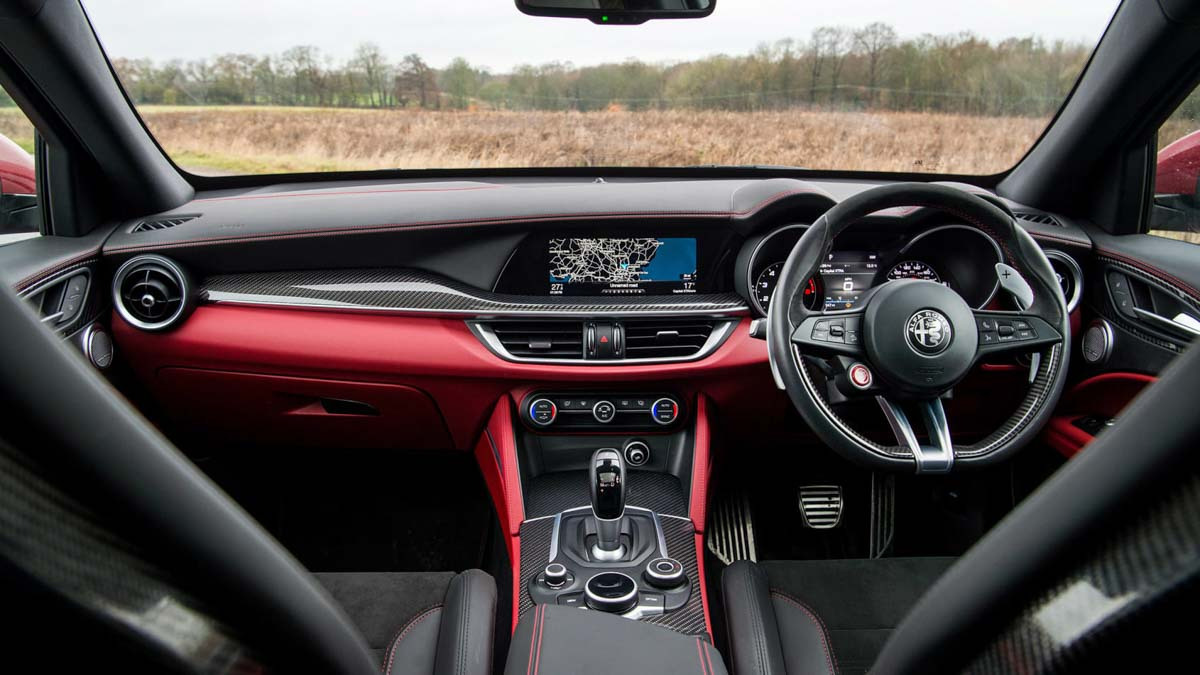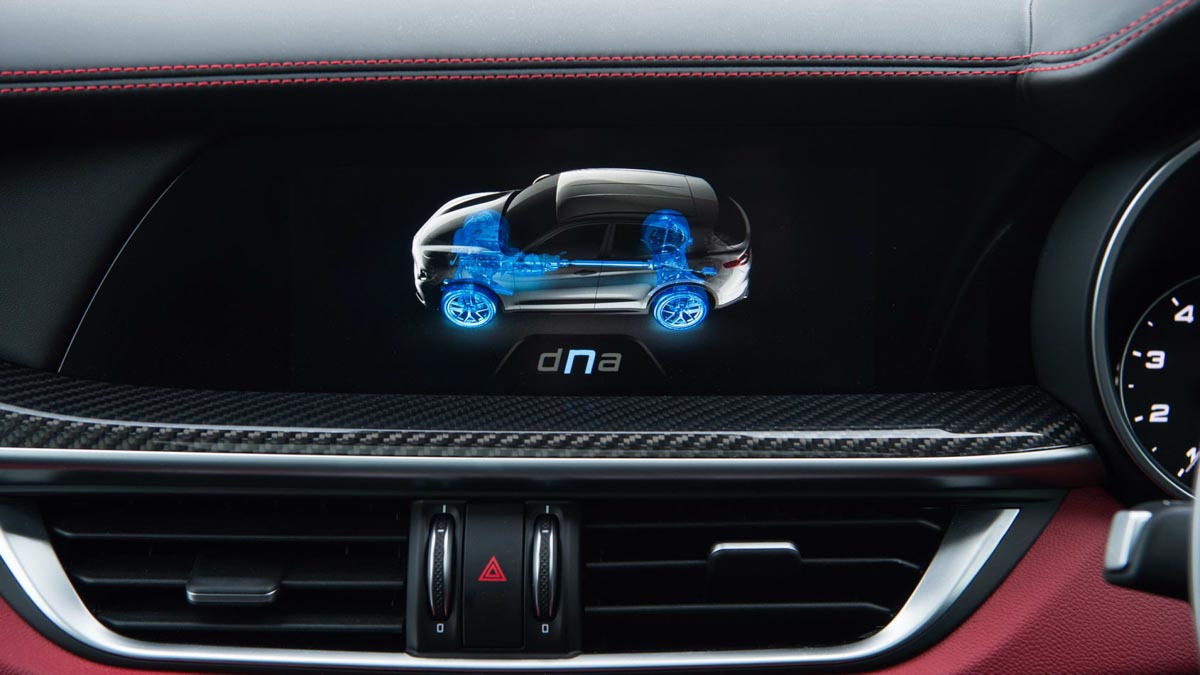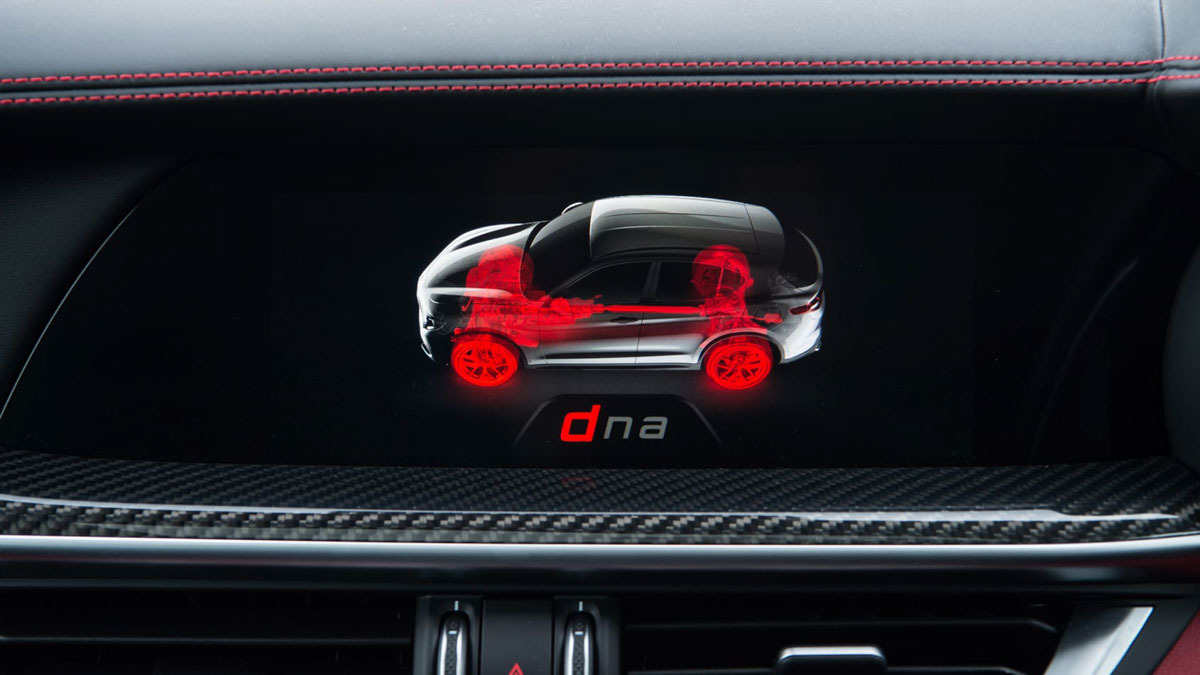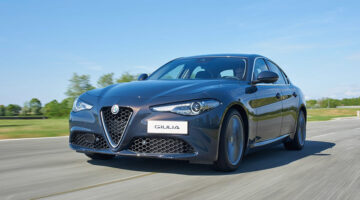Delivers as the most exciting performance SUV on sale, but has a few more rough edges than many rivals
| Fabulous powertrain and sweet chassis, special skunkworks feel | |
| For $90k the interior and tech lacks polish and is behind the times |
Is there anything cooler than knowing the car on your driveway was the result of a small, internal skunkworks-like team of designers and engineers working in defiance of a higher power? The Alfa Romeo Stelvio Quadrifoglio is such a car, launched alongside the Giulia Quadrifoglio saloon on a bespoke chassis with a bespoke 503bhp V6 derived from an engine made up the road in Maranello.
While our reservations about an SUV version of an otherwise perfectly practical family saloon are generally justified, the Stelvio is a different case. Yes, it has obvious compromises in terms of weight and its centre of gravity, but the Stelvio Quadrifoglio counters with a driving experience that isn’t a compromised take on the original, but one all of its own.
Like the Giulia, it had a great starting point, with that aforementioned skunkworks engineering team led by Roberto Fedeli, whose CV includes Ferrari’s 599, F12 and 458 Speciale.
Having undergone a subtle refresh in 2021, most of the mechanical hardpoints were left alone. Instead, new bits of interior trim and an update to the digital interfaces aimed to sharpen things right up. Has its appeal diminished? Not a bit of it, as while a Porsche Macan GTS might be more rounded, and a Jaguar F-Pace SVR more exuberant, the Stelvio remains the only truly engaging SUV, and one you’d happily drive just for the fun of it.

Prices, specs and rivals
The Stelvio Quadrifoglio is only available in one highly specified form at $89,174. All of the Stelvio’s dynamic features are standard too, including a valved sports exhaust system, Pro-DNA driver mode selector, adaptive dampers, and Alfa’s active torque vectoring rear differential to name a few. The sole mechanical upgrade option is a set of carbon-ceramic brakes which will set you back $7320, but the standard cast-iron discs do the job just fine away from a track.
With the 2021 update, so came two new tri-coat colour options, with the usual Competitzione Red joined by Lipari Ochre (a deep, heavy metallic gold) and the near-teal Montreal Green from the Giulia GTA. A fabulous new 21-inch telephone dial wheel design is also now available, but it does have a negative effect on the driving experience (more on that later) and is only available in black – are we done with black wheels yet?
Unpredictable manufacturing schedules surrounding factory orders and build slots make specific colour and trim options difficult to pin down, with only the black interior finish available locally at the moment. Models fitted with the optional $3900 Sparco carbonfibre-backed bucket seats switch basic silver stitching for the iconic green and white two-tone option. Otherwise, interior options are limited to a panoramic sunroof.
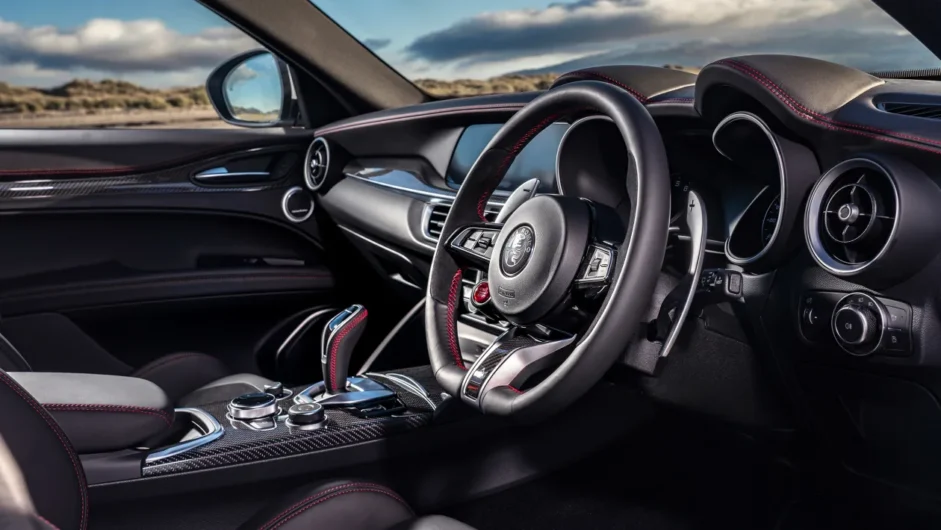
As for its many rivals, the identically powered BMW X3 M is more liberally equipped, but costs a chunkier $98,045. The BMW’s issue isn’t the price point though, rather its quite atrocious combination of a savage ride quality and numb handling. The Mercedes-AMG GLC63 S also hits with a 503bhp punch, this time from AMG’s venerable 4-litre twin-turbo V8, but is even pricier at $103,800, while lacking the Alfa’s poise and interaction. The Jaguar F-Pace SVR is a more worthy rival, again featuring a V8 engine, this time with even more power at 542bhp. It’s about right on price and standard equipment too, starting at $93,510.
The Alfa’s most adept rival was the Porsche Macan Turbo, but it’s been put out to pasture alongside the wider Macan’s update, leaving the $79,400 GTS as the most powerful rival. With only 434bhp, it’s nothing like as aggressive or entertaining as the Alfa, even if its broad capability is generally better. With a few choice options, the Stelvio knocks on the door of the larger $108,320 Cayenne GTS, which is once again down on power, but fights back with a bigger and more premium cabin, V8 engine and solid, if not sparkling dynamics.
Engine, gearbox and technical specs
Beneath the Stelvio Quadrifoglio’s aluminium bonnet is the 2.9-litre, twin-turbo V6 as found in the Giulia Quadrifoglio. Power is the same, at 503bhp, but the eight-speed ZF gearbox has been recalibrated to suit both the increase in kerb weight over the saloon and the four-wheel-drive transmission. It’s the first time this engine and gearbox combination has been offered with Alfa Romeo’s Q4 driveline.
Default mode for the Stelvio Quadrifoglio is rear-wheel drive, and it’s only when the system detects an angle of slip or a loss of traction that it will direct up to 50 per cent of the engine’s torque to the front wheels through a carbon propshaft. A rear limited-slip differential, active torque vectoring and Alfa’s Pro-DNA switchable drive mode system are all standard.

The Quadrifoglio comes fitted with cast-iron brakes, although carbon-ceramics are an option. Both 20- and 21-inch wheel packages are fitted with a Pirelli P Zero tyre by default – there’s no longer a Corsa option. A set of Pirelli winter tyres have also been homologated for the Stelvio Quadrifoglio.
Aluminium features extensively throughout the vehicle’s structure and chassis, keeping its weight comparatively low compared to rivals at 1830kg. If that sounds like a lot out of context, and it is, for reference the all-aluminium F-Pace SVR weighs in at 1995kg, despite only being marginally bigger on the road.
The suspension has the same engineering-first layout as the Giulia saloon, pairing a set of forged aluminium double wishbones at the front to a four-and-a-half-link system at the rear. The doors, brake carriers, wheelarches and the engine are all made of aluminium too, and the bonnet is made of carbon.
Performance and 0-100 time
Thanks in large part to the extra traction granted by the Stelvio’s all-wheel-drive system, the Quadrifoglio will reach 100kph in 3.8sec and crack 283kph – that’s 0.7sec quicker than Porsche’s claim for the Macan GTS and 11kph faster flat out, too.
The all-wheel-drive system also dramatically improves traction in slippery conditions, which, let’s face it, represents here more broadly than the sun-baked tarmac of Italy. As a result, the urge generated from the twin-turbocharged engine across the board is more useable regardless of the weather, although it is still useful to remember that this is a part-time rear-biased system so it’ll still squirm if you’re too greedy with the throttle.
But the real star of the show is that V6 engine. Its power delivery isn’t just rapid, it’s savage, ripping up the rev range with incredible urgency – it almost feels as if the car’s on a rolling road. There’s also a real timbre to its exhaust note, and together with the supercar-like pace makes the Stelvio’s powertrain distinctly enjoyable at all speeds.
Ride and handling
From the get-go it feels light and responsive and benefits from the quick and direct steering similar to the Giulia Quadrifoglio’s, giving it a level of response that’s unmatched for a tallish SUV weighing the wrong side of 1800kg. The steering’s interaction with the wheels is backed up by the Quad’s intense geometry set-up, which like the most aggressive sports and supercars compromises on day-to-day useability – the turning circle’s rubbish, and there’s lots of scrub on full-lock – for the sake of front-end grip and response. The steering doesn’t unnaturally amplify the axle’s capability like it sometimes can in some rivals, instead it merely gives you more access to more grip, more of the time.
This isn’t harmed by the front axle’s need to put power down either, as the steering remains largely free of any corruption. It just feels like the Stelvio is rear-wheel drive with an unnatural amount of traction – a similar feeling to that felt on modern BMW M products with xDrive fitted.
Overall, the 2.9-litre V6 loses none of its brio with the extra weight and driven wheels attached to it. Left in automatic mode the ZF delivers each ratio with an instant, seamless shift, but as with the Giulia, you’ll want to use the beautiful aluminium paddles fitted to the steering column and change gear yourself. Unless you’re in Race mode, the gearbox doesn’t change as you approach a corner, instead waiting for you to get on the power before kicking down.

You’ll also want to select Dynamic or Race mode on the Pro-DNA system, even if you’re using manual mode, because not only do the throttle’s response and the ZF’s shifts sharpen up, but the ESP loosens its reins, too (it switches off all together in Race mode) and the exhaust valves open to increase the volume. The result is rabid performance and an evocative soundtrack as the Stelvio bursts from corner to corner, devouring straights at a rate Audi RS, BMW M and Mercedes-AMG saloon and coupe owners will recognise.
The Pro-DNA settings also alter the dampers’ stiffness. On local roads there isn’t the same noticeable change in the ride between the softest setting and the intermediate level that you get when you select Dynamic mode – it stays firm and tense; much less forgiving than the Giulia Quadrifoglio, but still not uncomfortable. Although the ride feels much the same between the two modes, body roll and pitch is far better contained in Dynamic and, even on the winter tyres our road test car was fitted with, it felt sharp and direct. In Race, the dampers felt too firm as bumps made the car bounce and feel unsettled. However, the damper button in the middle of the Pro-DNA dial allows you to tone down the dampers by one setting, so in Race mode you can select the Dynamic dampers.
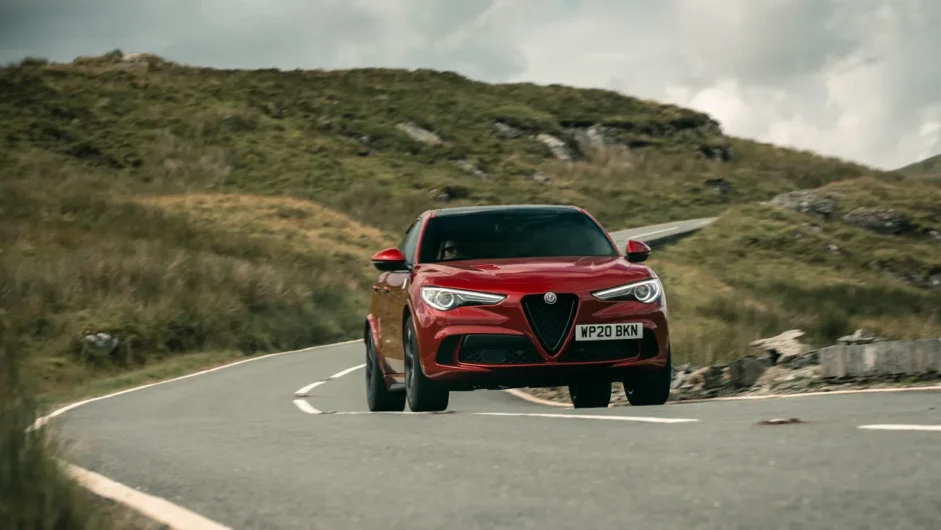
It’s this combination – Race for the lack of driver assistance systems, the engine noise and the fastest gearchanges, and Dynamic for the dampers – that works perfectly on local roads. The Stelvio Quadrifoglio feels so natural to be driven quickly that you feel completely confident attacking a B-road with no stability control. Yes, the car will oversteer if the back end isn’t loaded up, but the steering is fast, allowing you to easily apply whatever corrective lock is necessary, so if you do encounter a slide you can easily correct it.
There is one caveat surrounding the new 21-inch wheel option, though, as despite looking the absolute bomb they do have a negative effect on the primary and secondary ride quality. Unfortunately, it’s clear the new wheels did not incur any new calibration work from engineers, upsetting the fine balance struck on the standard 20-inch units and their taller sidewalls. As a result, cars on the 21s are more susceptible to crashing into potholes and ridges in the road with a seriously detrimental effect. The firm, but controlled feel of the standard car is gone, replaced by a brittleness that does have you wincing over rough sections of road. There’s also more negative feedback through the wheel as it will sometimes kick back with a vengeance.
L/100km and running costs
Alfa Romeo’s official L/100km rating (on the old NEDC cycle admittedly) is 9.8L/100km, a figure that’s difficult to match in the real world. Over the course of more than eight months with one on our Fast Fleet, we managed an average of 13.3L/100km, but found on limited occasions it would rise to closer to 9.4L/100km on gentle motorway cruises.
Over the course of nearly 29,000 kilometers it also needed an oil change, which cost just over $360, and two sets of rubber (one being winter rubber, admittedly) that cost somewhere around $1000 for a set. The Pirelli P Zero standard rubber performed well, but the aggressive geometry set-up and low wear rating will make tyres an expensive enterprise, especially if you upgrade to the new 21-inch options.

There are also some question marks over the long-term reliability of the power and drivetrains, as with Stelvios now coming to the end of their warranty period, dealership workshops have started murmuring about issues surrounding the turbochargers and differentials. Still, given the old Selespeed transmissions and electrics of previous generations of Alfa Romeos this shouldn’t come as a surprise.
The extreme stance of those tyres will also make regular touch ups around the lower surfaces a requirement if you wish to keep it free of excessive stone chips. The aggressive geometry also will need constant attention, as the steering operates on a knife-edge, something only exaggerated by the quick and light steering rack.
Interior and tech
Although there is plenty to like about the Stelvio’s skunkwork’s development style, the result is the outright package just isn’t as polished and premium as those of most rivals. This is most evident in the interior, which struggles to warrant the Quad’s near $90,000 price tag due to questionable build quality.
Granted, standard kit is pretty substantial and the basics are right, such as the firm, yet supportive seats, well-shaped and nicely trimmed steering wheel and wonderfully tactile aluminium paddles behind, but the overall interior is just not up to the high standards seen in rivals such as the Porsche Macan.

Something that also seems a tad compromised is the seating position, which like in many SUVs with saloon car origins, seems to canter the driver forward ever so slightly, as the steering wheel doesn’t so much level out in front of you as rise from somewhere lower beneath your feet. If you’ve driven a Volkswagen Tiguan, you’ll know what we mean.
Interior space is otherwise good, sitting somewhere between that of an Audi Q3 and Q5, and the boot is certainly more than big enough to cope with an evo photographer’s gear as Aston Parrott found out after running one as a long-term test car.
Design
The Stelvio Quadrifoglio sure is a divisive design, with many loving its pumped-up shape and aggressive detailing. If there is one inarguable fact, it is that the Stelvio certainly looks like little else on the road, with its big triangular grille and those classic telephone dial wheels.
To others though, the Stelvio’s odd proportions and lack of a rear three-quarter window make it look like a very large hatchback, especially when seen in context of other road cars. The big headlights and lack of any rugged styling elements only accentuates this odd aesthetic.
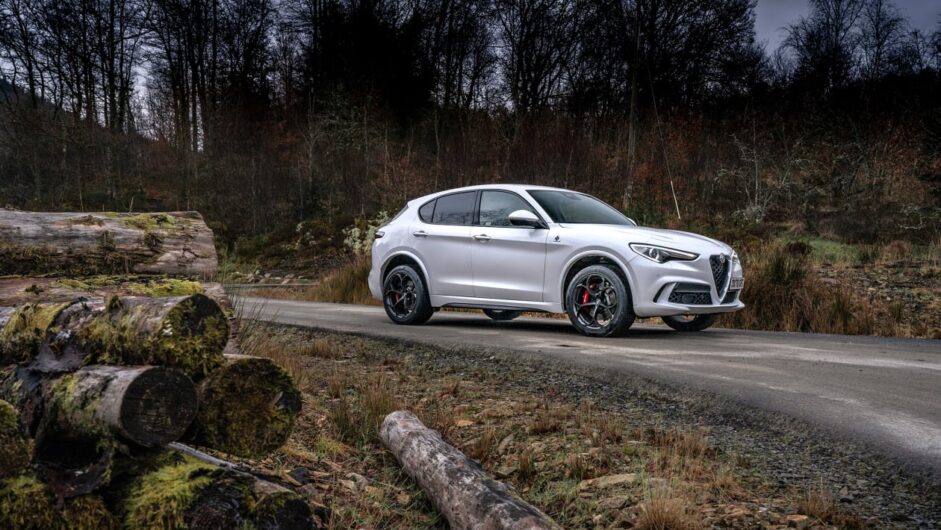
What it does have is presence, sitting purposefully on its slightly oversized wheels and tyres, and thanks to its aggressive intakes and offset exhaust pipes. Of the performance SUV type, it’s more distinctive than the Porsche Macan, more dynamic than any performance Range Rover, if not quite as purposeful as the Jaguar F-Pace SVR.
And yet, in one of its brighter colours, and with those new 21-inch wheels, the Stelvio has a similar feel to an Alpine A110 that’s been through the Atelier programme, or even a PTS Porsche – something that’s designed specifically for you, bespoke and special. This isn’t a car to just ditch in three years’ time after the PCP has ended, but will act as a very special point and time in automotive development.
Living with it
Aston Parrott
I knew the day would eventually come, but it didn’t make the Stelvio’s departure any easier. I wasn’t entirely sure what to expect when I was first handed the key, but now the Alfa has gone I’m really missing the versatility of an SUV with 503bhp.
The last SUV I ran was a Nissan Juke Nismo RS, and the first time I turned up to a photoshoot with it, Dickie Meaden and Jethro Bovingdon instantly burst out laughing. This was not the case with the Alfa Romeo Stelvio Quadrifoglio. This time the responses were more along the lines of: ‘Is that your new long-termer? Nice work. They’re meant to be good…’ Over my eight months with it, that praise would start to look like an understatement.
So the Alfa had the nod of approval, and why wouldn’t it? It had plenty going for it, with a powerful V6 engine, a great-sounding exhaust note, carbonfibre Sparco seats (a $4030 option) and beautifully designed wheels. And best of all it was an Alfa Romeo.
Almost the only thing counting against it was the fact that it was also an SUV. Yet while on paper it had rivals in terms of performance and price ($86,221 basic, $97,939 with options for our car), it proved to be far more interesting to be in and drive than the majority of its rivals. It certainly received more looks and attention than other SUVs. OK, maybe not more than a Lamborghini Urus, but the last time I was in one of those it received the kind of reactions you don’t want. But there were no such problems with the Alfa, which traded brash for beautiful. Well, beautiful for an SUV at any rate.
I had so many great drives in the Stelvio, but one that particularly sticks in my mind was during issue 252’s supercar test, featuring the 488 Pista, 911 GT3 RS, 720S Track Pack and Aventador SVJ. I loved the fact that, despite the abilities of the test cars the Stelvio was mixing with, I wasn’t completely left behind as we moved between photo locations. This was particularly impressive when you consider that I also had a bootful of camera, lighting and rigging gear, plus cleaning kits, my travel bag… and a stepladder.
The roads on that Scottish shoot were brilliant and gave me a chance to explore the Stelvio’s abilities – and it really could be hustled, although ultimately allowances still had to be made for its weight and height. Not that driving an SUV didn’t have its advantages, as was brought home to me upon finding the road ahead flooded when driving home one evening.

Overall I covered 28,057 kilometres in the Alfa. During that distance it had an oil-change service at 14,500 kilometres ($376.20), a set of Pirelli Scorpion winter tyres ($1152), and a fresh set of Pirelli P Zeros ($1124). It typically cost just over $90 to fill the tank, providing a range of around 480 kilometres. The overall L/100km average was 21.3, while the best I saw was 8.6L/100km on a long motorway drive in Eco mode.
When it came to reliability, this Alfa proved very good, with only two small issues. One was when the performance turned sluggish and access to the sports driving modes was denied. This problem vanished after the next refill, so we suspect a bad batch of 95-octane fuel may have been to blame. The second issue was a flat battery after the car was left unlocked for several days by an airport parking firm. Once jump-started, the car went into ‘limp home’ mode for a couple of hours until the battery was recharged, then all returned to normal.
Despite its impressive performance, direct steering and strong brakes, jumping back into the Stelvio after a stint in my 993 Carrera I felt like I was driving a lorry. It was a reminder of what you miss out on when you opt for a performance SUV rather than a more conventional performance car, but it is to Alfa’s credit that even though I was sitting up high, I was still held firmly in place by those excellent seats. Actually, I liked everything Alfa has done for the driver inside the Quadrifoglio. The general design was very clean, but with a sporty edge thanks to the combination of carbon, Alcantara and red leather. The steering wheel had a lovely feel to it and the instrument dials fitted perfectly within its curve. And the upgraded Harman Kardon sound system ($1180) was always appreciated on long journeys. The only thing I would like to have seen was a smart touchscreen, as I mostly use Apple CarPlay and the set-up as it was was a little clumsy to use. But all good things must come to an end, and our Alfa Stelvio Quadrifoglio was very good indeed.
This article originally appeared at evo.co.uk
Copyright © evo UK, Dennis Publishing









